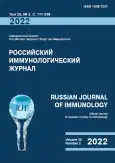Оценка параметров митохондрий CD4+Т-лимфоцитов периферической крови методом проточной цитофлюориметрии
- Авторы: Королевская Л.Б.1, Сайдакова Е.В.1, Шмагель К.В.1
-
Учреждения:
- Институт экологии и генетики микроорганизмов Уральского отделения Российской академии наук – филиал ФГБУН «Пермский федеральный исследовательский центр Уральского отделения Российской академии наук»
- Выпуск: Том 25, № 2 (2022)
- Страницы: 207-212
- Раздел: КРАТКИЕ СООБЩЕНИЯ
- URL: https://journal-vniispk.ru/1028-7221/article/view/120194
- DOI: https://doi.org/10.46235/1028-7221-1106-FCA
- ID: 120194
Цитировать
Полный текст
Аннотация
Митохондрии играют ключевую роль в жизненно важных функциях клетки: производстве энергии, метаболизме, клеточном дыхании, продукции активных форм кислорода, делении и гибели. Нарушение функций этих органелл ассоциировано с развитием различных заболеваний. Важными показателями состояния митохондрий являются их масса и мембранный потенциал. Для оценки этих параметров используют различные флюорохром-меченые зонды, которые можно детектировать методом проточной цитометрии. Возможность использования флуоресцентных митохондриальных красителей совместно с мечеными моноклональными антителами открывает широкие перспективы для изучения метаболических параметров разнообразных клеток иммунной системы. Целью данного исследования была оценка состояния митохондрий CD4+Т-лимфоцитов методом проточной цитофлюориметрии. Для демонстрации различий параметров митохондрий в качестве групп сравнения были взяты ВИЧ-инфицированные пациенты, получающие антиретровирусную терапию (n = 21), и относительно здоровые добровольцы (n = 23). Объектом исследования служили мононуклеарные клетки, выделенные из периферической крови. Методом проточной цитометрии с использованием коммерческих митохондриально-селективных красителей MitoTracker Green и MitoTracker Orange были определены, соответственно, масса и заряд мембраны митохондрий в общем пуле CD4+Т-лимфоцитов, а также в субпопуляциях наивных клеток и клеток памяти. Показано, что как у ВИЧ-инфицированных, так и неинфицированных субъектов масса и заряд митохондрий в наивных CD4+Т-лимфоцитах ниже, чем в клетках памяти. Установлено, что по сравнению со здоровыми донорами у ВИЧ-инфицированных больных повышена масса митохондрий в общем пуле CD4+Т-лимфоцитов и в субпопуляции клеток памяти, что, однако, не сопровождается ростом заряда мембраны органелл. Таким образом, цитофлюориметрическое определение массы и мембранного потенциала митохондрий с использованием красителей MitoTracker Green и MitoTracker Orange является относительно легким, быстрым и информативным способом предварительной оценки состояния органелл в клетках.
Ключевые слова
Полный текст
Открыть статью на сайте журналаОб авторах
Лариса Борисовна Королевская
Институт экологии и генетики микроорганизмов Уральского отделения Российской академии наук – филиал ФГБУН «Пермский федеральный исследовательский центр Уральского отделения Российской академии наук»
Автор, ответственный за переписку.
Email: bioqueen@mail.ru
ORCID iD: 0000-0001-9840-7578
к.м.н., научный сотрудник лаборатории экологической иммунологии
Россия, 614081, Пермь, ул. Голева, 13Евгения Владимировна Сайдакова
Институт экологии и генетики микроорганизмов Уральского отделения Российской академии наук – филиал ФГБУН «Пермский федеральный исследовательский центр Уральского отделения Российской академии наук»
Email: radimira@list.ru
ORCID iD: 0000-0002-4342-5362
Scopus Author ID: 54882274000
ResearcherId: C-8333-2015
д.б.н., заведующая лабораторией молекулярной иммунологии
Россия, 614081, Пермь, ул. Голева, 13Константин Владимирович Шмагель
Институт экологии и генетики микроорганизмов Уральского отделения Российской академии наук – филиал ФГБУН «Пермский федеральный исследовательский центр Уральского отделения Российской академии наук»
Email: shmagel@iegm.ru
ORCID iD: 0000-0001-6355-6178
д.м.н., заведующий лабораторией экологической иммунологии
Россия, 614081, Пермь, ул. Голева, 13Список литературы
- Annesley S.J., Fisher P.R. Mitochondria in health and disease. Cells, 2019, Vol. 8, no. 7, pp. 680-687.
- Breda C.N.S., Davanzo G.G., Basso P.J., Saraiva Camara N.O., Moraes-Vieira P.M.M. Mitochondria as central hub of the immune system. Redox Biol., 2019, Vol. 26, pp. 101255-101272.
- Campos C.B., Paim B.A., Cosso R.G., Castilho R.F., Rottenberg H., Vercesi A.E. Method for monitoring of mitochondrial cytochrome c release during cell death: Immunodetection of cytochrome c by flow cytometry after selective permeabilization of the plasma membrane. Cytometry A, 2006, Vol. 69, no. 6, pp. 515-523.
- Cottet-Rousselle C., Ronot X., Leverve X., Mayol J.F. Cytometric assessment of mitochondria using fluorescent probes. Cytometry A, 2011, Vol. 79, no. 6, pp. 405-425.
- Dimeloe S., Frick C., Fischer M., Gubser P.M., Razik L., Bantug G.R., Ravon M., Langenkamp A., Hess C. Human regulatory T cells lack the cyclophosphamide-extruding transporter ABCB1 and are more susceptible to cyclophosphamide-induced apoptosis. Eur. J. Immunol., 2014, Vol. 44, no. 12, pp. 3614-3620.
- Fan H.H., Tsai T.L., Dzhagalov I.L., Hsu C.L. Evaluation of mitochondria content and function in live cells by multicolor flow cytometric analysis. Methods Mol. Biol., 2021, Vol. 2276, pp. 203-213.
- Kauffman M.E., Kauffman M.K., Traore K., Zhu H., Trush M.A., Jia Z., Li Y.R. MitoSOX-based flow cytometry for detecting mitochondrial ROS. React. Oxyg. Species (Apex), 2016, Vol. 2, no. 5, pp. 361-370.
- Masson J.J.R., Murphy A.J., Lee M.K.S., Ostrowski M., Crowe S.M., Palmer C.S. Assessment of metabolic and mitochondrial dynamics in CD4+ and CD8+ T cells in virologically suppressed HIV-positive individuals on combination antiretroviral therapy. PLoS One, 2017, Vol. 12, no. 8, e0183931. doi: 10.1371/journal.pone.0183931.
- Perry C.G.R., Hawley J.A. Molecular basis of exercise-induced skeletal muscle mitochondrial biogenesis: historical advances, current knowledge, and future challenges. Cold Spring Harb. Perspect. Med., 2018, Vol. 8, no. 9, a029686. doi: 10.1101/cshperspect.a029686
- Perry S.W., Norman J.P., Barbieri J., Brown E.B., Gelbard H.A. Mitochondrial membrane potential probes and the proton gradient: a practical usage guide. Biotechniques, 2011, Vol. 50, no. 2, pp. 98-115.
- Presley A.D., Fuller K.M., Arriaga E.A. MitoTracker Green labeling of mitochondrial proteins and their subsequent analysis by capillary electrophoresis with laser-induced fluorescence detection. J. Chromatogr. B Analyt. Technol. Biomed. Life Sci, 2003, Vol. 793, no. 1, pp. 141-150.
- Solaini G., Sgarbi G., Lenaz G., Baracca A. Evaluating mitochondrial membrane potential in cells. Biosci. Rep., 2007, Vol. 27, no. 1-3, pp. 11-21.
- Sun H., Li X. Metabolic reprogramming in resting and activated immune cells. Metabolomics (Los Angel.), 2017, Vol. 7, no. 1, pp. 188-194.
- Yu F., Hao Y., Zhao H., Xiao J., Han N., Zhang Y., Dai G., Chong X., Zeng H., Zhang F. Distinct mitochondrial disturbance in CD4+T and CD8+T cells from HIV-infected patients. J. Acquir. Immune Defic. Syndr., 2017, Vol. 74, no. 2, pp. 206-212.
Дополнительные файлы









